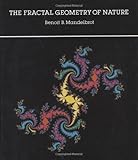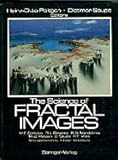|
|
Help |
| Home - Basic M - Mandelbrot Fractals (Books) | |
e99 Online Shopping Mall
|
|
Help |
| Home - Basic M - Mandelbrot Fractals (Books) | |
| 1-20 of 53 | Next 20 |
click price to see details click image to enlarge click link to go to the store
| 1. The Fractal Geometry of Nature by Benoit B. Mandelbrot | |
 | Hardcover: 468
Pages
(1983)
list price: US$50.00 -- used & new: US$35.60 (price subject to change: see help) Asin: 0716711869 Average Customer Review: Canada | United Kingdom | Germany | France | Japan |
|
Editorial Review Product Description The Fractal Geometry ofNature is a mathematics text. But buried in the deltas and lambdasand integrals, even a layperson can pick out and appreciateMandelbrot's point: that somewhere in mathematics, there is anexplanation for nature. It is not a coincidence that fractal math isso good at generating images of cliffs and shorelines and capillarybeds. Customer Reviews (20)
| |
| 2. The Misbehavior of Markets: A Fractal View of Financial Turbulence by Benoit Mandelbrot, Richard L. Hudson | |
 | Paperback: 368
Pages
(2006-03-07)
list price: US$18.95 -- used & new: US$8.95 (price subject to change: see help) Asin: 0465043577 Average Customer Review: Canada | United Kingdom | Germany | France | Japan |
|
Editorial Review Product Description Mathematical superstar and inventor of fractal geometry, Benoit Mandelbrot, has spent the past forty years studying the underlying mathematics of space and natural patterns. What many of his followers don't realize is that he has also been watching patterns of market change. In The (Mis)Behavior of Markets, Mandelbrot joins with science journalist and former Wall Street Journal editor Richard L. Hudson to reveal what a fractal view of the world of finance looks like. The result is a revolutionary reevaluation of the standard tools and models of modern financial theory. Markets, we learn, are far riskier than we have wanted to believe. From the gyrations of IBM's stock price and the Dow, to cotton trading, and the dollar-Euro exchange rate--Mandelbrot shows that the world of finance can be understood in more accurate, and volatile, terms than the tired theories of yesteryear.The ability to simplify the complex has made Mandelbrot one of the century's most influential mathematicians. With The (Mis)Behavior of Markets, he puts the tools of higher mathematics into the hands of every person involved with markets, from financial analysts to economists to 401(k) holders. Markets will never be seen as "safe bets" again. Customer Reviews (71)
| |
| 3. Gaussian Self-Affinity and Fractals by Benoit Mandelbrot | |
 | Hardcover: 664
Pages
(2001-12-14)
list price: US$97.00 -- used & new: US$4.87 (price subject to change: see help) Asin: 0387989935 Canada | United Kingdom | Germany | France | Japan |
|
Editorial Review Product Description | |
| 4. Fractals and Chaos: The Mandelbrot Set and Beyond by Benoit B. Mandelbrot | |
 | Hardcover: 308
Pages
(2004-01-09)
list price: US$69.95 -- used & new: US$44.26 (price subject to change: see help) Asin: 0387201580 Canada | United Kingdom | Germany | France | Japan |
|
Editorial Review Product Description --From the foreword by Peter W Jones, Yale University This book provides a history of the Mandelbrot set of quadratic dynamics together with the authors hard-to-find early papers. It has extensive illustrations throughout and is divided into four sections: quadratic dynamics, klein groups, Minkowski measures, and Julia sets. Each section starts with introductory chapters giving historical context and background to the material. Benoit B Mandelbrot is Sterling Professor of Mathematical Sciences at Yale University and IBM Fellow Emeritus (Physics) at the IBM T J Watson Research Center. He was awarded the Wolf Prize for Physics in 1993 and the Japan Prize for Science and Technology in 2003. | |
| 5. The Science of Fractal Images | |
 | Hardcover: 312
Pages
(1988-07-19)
list price: US$64.95 -- used & new: US$39.99 (price subject to change: see help) Asin: 0387966080 Average Customer Review: Canada | United Kingdom | Germany | France | Japan |
|
Editorial Review Product Description Customer Reviews (4)
This book reads at any level, Great introduction to the field as well as an indespencible reference. Shows easy to implement code examples, and has lots of pictures showing what can beacheived. This has been a main reference for a theisis I am currentlyworking on. The question is, why is it out of print. If you can find itit's worth it's wheight in gold.
| |
| 6. Fractals, Graphics, and Mathematics Education (Mathematical Association of America Notes) by Benoit Mandelbrot, Michael Frame | |
 | Paperback: 224
Pages
(2002-05-01)
list price: US$49.95 -- used & new: US$44.69 (price subject to change: see help) Asin: 0883851695 Average Customer Review: Canada | United Kingdom | Germany | France | Japan |
|
Editorial Review Product Description Customer Reviews (1)
| |
| 7. Fractals and Scaling In Finance: Discontinuity, Concentration, Risk by Benoit B. Mandelbrot | |
 | Kindle Edition: 551
Pages
(1997-09-18)
list price: US$74.95 Asin: B003VM7FZC Average Customer Review: Canada | United Kingdom | Germany | France | Japan |
|
Editorial Review Product Description PHYSICS TODAY"At once a compendium of Mandelbrot's pioneering work and a sampling of new results, the presentation seems modeled on the brilliant avant-garde film 'Last Year in Marienbad', in which the usual flow of time is suspended, and the plot is gradually revealed by numerous but slightly different repetitions of a few repetitions of a few underlying events...Mandelbrot writes with economy and felicity, and he intersperses the more mathematical sections with frank historical anecdotes, such as the events that led up to his work on cotton pricing and the embarrassment caused by interpreting US Department of Agriculture data for weekly averages as 'Sunday closing prices.' There are many fascinating asides on a variety of topics, ranging from the importance of computer graphics in science to the distribution of insurance claims resulting from fire damage...The reader who is open-minded and prepared to indulge one of our more influential and original thinkers will be amply awarded. All in all, this is a strange but wonderful book. It will not suit everyone's taste but will almost surely teach every reader something new. What more can one ask?" Customer Reviews (4)
| |
| 8. An Eye For Fractals: A Graphic And Photographic Essay (Studies in Nonlinearity) by Michael Mcguire, Benoit B. Mandelbrot | |
| Hardcover: 176
Pages
(1991-07-21)
list price: US$40.00 -- used & new: US$17.74 (price subject to change: see help) Asin: 0201554402 Average Customer Review: Canada | United Kingdom | Germany | France | Japan | |
|
Editorial Review Product Description Customer Reviews (4)
Fractal geometry is revolutionizing the way thatscientists perceive the universe and its underlying order.Anyone canbenefit greatly from this understanding by reading this book. ... Read more | |
| 9. Fractal Landscapes by Bill Hirst, Benoit B. Mandelbrot | |
| Paperback: 80
Pages
(1994-11-01)
-- used & new: US$26.78 (price subject to change: see help) Asin: 0948797231 Canada | United Kingdom | Germany | France | Japan | |
| 10. Fractals in Physics: Essays in Honour of Benoit B Mandelbrot : Proceedings of the International Conference Honouring Benoit B Mandelbrot on His 65th by Amnon Aharony | |
| Paperback: 400
Pages
(1990-06)
list price: US$51.50 -- used & new: US$84.99 (price subject to change: see help) Asin: 044488646X Average Customer Review: Canada | United Kingdom | Germany | France | Japan | |
Customer Reviews (1)
| |
| 11. Physics and Fractal Structures by Jean-Francois Gouyet | |
 | Hardcover: 234
Pages
(1996-05-29)
list price: US$69.95 -- used & new: US$24.99 (price subject to change: see help) Asin: 0387941533 Canada | United Kingdom | Germany | France | Japan |
|
Editorial Review Product Description | |
| 12. From Newton to Mandelbrot: A Primer in Theoretical Physics with Fractals for the Macintosh (R) by Dietrich Stauffer, H. Eugene Stanley | |
 | Paperback: 212
Pages
(1995-09-21)
list price: US$42.95 -- used & new: US$42.95 (price subject to change: see help) Asin: 3540591915 Canada | United Kingdom | Germany | France | Japan |
|
Editorial Review Product Description | |
| 13. Fractals for the Classroom: Part Two: Complex Systems and Mandelbrot Set by Heinz-Otto Peitgen, Hartmut Jürgens, Dietmar Saupe | |
 | Hardcover: 500
Pages
(1992-08-26)
list price: US$64.95 -- used & new: US$46.96 (price subject to change: see help) Asin: 0387977228 Average Customer Review: Canada | United Kingdom | Germany | France | Japan |
|
Editorial Review Product Description Customer Reviews (2)
| |
| 14. Fractals and Chaos: The Mandelbrot Set and Beyond by Benoit Mandelbrot | |
| Paperback: 308
Pages
(2010-11-02)
list price: US$69.95 -- used & new: US$58.58 (price subject to change: see help) Asin: 1441918973 Canada | United Kingdom | Germany | France | Japan | |
|
Editorial Review Product Description Just 23 years ago Benoit Mandelbrot published his famous picture of the Mandelbrot set, but that picture has changed our view of the mathematical and physical universe. In this text, Mandelbrot offers 25 papers from the past 25 years, many related to the famous inkblot figure. Of historical interest are some early images of this fractal object produced with a crude dot-matrix printer. The text includes some items not previously published. | |
| 15. Fractals in Geophysics by Christopher H. Scholz | |
| Paperback:
Pages
(1989-10)
list price: US$34.50 Isbn: 0817622063 Canada | United Kingdom | Germany | France | Japan | |
| 16. From Newton to Mandelbrot: A Primer in Theoretical Physics with Fractals for the Personal Computer by Dietrich Stauffer, H.Eugene Stanley | |
 | Paperback: 209
Pages
(1995-10-26)
list price: US$57.95 -- used & new: US$40.19 (price subject to change: see help) Asin: 3540565892 Canada | United Kingdom | Germany | France | Japan |
|
Editorial Review Product Description | |
| 17. Fractal Geometry And Applications: A Jubilee Of Benoit Mandelbrot (Proceedings of Symposia in Pure Mathematics) | |
 | Hardcover: 1110
Pages
(2004-12-24)
list price: US$177.00 -- used & new: US$148.69 (price subject to change: see help) Asin: 0821832921 Canada | United Kingdom | Germany | France | Japan |
|
Editorial Review Product Description In demonstrating the vitality and diversity of the field, this book will motivate further investigation into the many open problems and inspire future research directions. It is suitable for graduate students and researchers interested in fractal geometry and its applications. This is a two-part volume. Part 1 covers analysis, number theory, and dynamical systems; Part 2, multifractals, probability and statistical mechanics, and applications. | |
| 18. Fractal Art Postcard Book: The Mandelbrot Set (Postcard Portfolio) by Mandelbrot Set | |
 | Paperback: 30
Pages
(1998-07-28)
list price: US$8.95 -- used & new: US$49.50 (price subject to change: see help) Asin: 0883639491 Canada | United Kingdom | Germany | France | Japan |
|
Editorial Review Product Description | |
| 19. Fractal Theory and Benoit Mandelbrot: An entry from Gale's <i>Science and Its Times</i> by David Tulloch | |
| Digital: 4
Pages
(2001)
list price: US$5.90 -- used & new: US$5.90 (price subject to change: see help) Asin: B0027UWYQ4 Canada | United Kingdom | Germany | France | Japan | |
|
Editorial Review Product Description | |
| 20. A new digital signature scheme based on Mandelbrot and Julia fractal sets.: An article from: American Journal of Applied Sciences by Mohammad Ahmad Alia, Azman Bin Samsudin | |
| Digital: 19
Pages
(2007-11-01)
list price: US$9.95 -- used & new: US$9.95 (price subject to change: see help) Asin: B0012D115M Canada | United Kingdom | Germany | France | Japan | |
|
Editorial Review Product Description | |
| 1-20 of 53 | Next 20 |